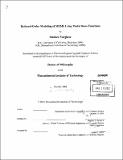Reduced-order modeling of MEMS using modal basis functions
Author(s)
Varghese, Mathew, 1973-
DownloadFull printable version (6.728Mb)
Alternative title
Reduced-order modeling of microelectromechanical systems using modal basis functions
Other Contributors
Massachusetts Institute of Technology. Dept. of Electrical Engineering and Computer Science.
Advisor
Stephen D. Senturia.
Terms of use
Metadata
Show full item recordAbstract
The field of MEMS has matured significantly over the last two decades increasing in both complexity and level of integration. To keep up with the demands placed by these changes requires the development of computer-aided design and modeling tools (CAD/CAM) that enable designers to reduce the time and cost it takes to produce working prototypes. An ideal scenario is one in which a designer is able to quickly model and simulate an entire microsystem - sensors, actuators and electronics -- with the certainty that their results will match that of physical prototypes. This vision of design requires the existence of system level models of MEMS devices that can capture the complex non-linear coupling between multiple physical domains, yet be sufficiently fast and compact in form to insert into a system dynamics simulator. In this thesis I explore techniques of automatically constructing such models from meshed representations of device geometry. These dynamical models are known as "reduced-order" models or "macromodels." They are characterized by few degrees of freedom (DOF), and a small set of state equations. Our process for constructing macromodels is built upon two well-established methodologies - normal mode superposition and Lagrangian mechanics. This is referred to as the "CHURN process" and was originally developed by Gabbay et al. to create models of electromechanical devices with two electrodes under conditions satisfying linear mechanics. (cont.) In this thesis I significantly extend this process to model multi-port magnetostatic devices, multi-port electrostatic devices, and geometrically non-linear mechanical devices exhibiting stress stiffening. I also address one of the key concerns in building macromodels -- the required degree of sophistication, and the extent of involvement, of a designer in the model construction process. I propose and implement several heuristic techniques that automate the model generation process. I also apply these techniques to a fabricated microelectromechanical high frequency filter and present verification of our modeling results.
Description
Thesis (Ph. D.)--Massachusetts Institute of Technology, Dept. of Electrical Engineering and Computer Science, February 2002. Includes bibliographical references (p. 80-84).
Date issued
2002Department
Massachusetts Institute of Technology. Department of Electrical Engineering and Computer SciencePublisher
Massachusetts Institute of Technology
Keywords
Electrical Engineering and Computer Science.